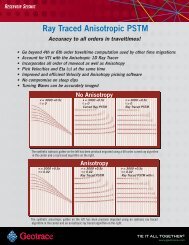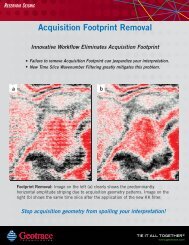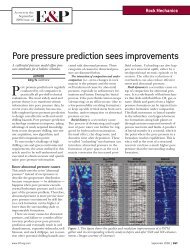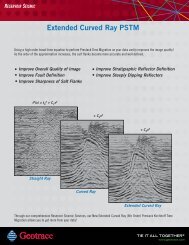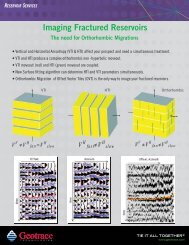Gas-oil contact monitoring at Troll using high resolution 4D analysis ...
Gas-oil contact monitoring at Troll using high resolution 4D analysis ...
Gas-oil contact monitoring at Troll using high resolution 4D analysis ...
Create successful ePaper yourself
Turn your PDF publications into a flip-book with our unique Google optimized e-Paper software.
1Z-99 <strong>Gas</strong>-<strong>oil</strong> <strong>contact</strong> <strong>monitoring</strong> <strong>at</strong> <strong>Troll</strong> <strong>using</strong> <strong>high</strong><strong>resolution</strong> <strong>4D</strong> <strong>analysis</strong> and neural networksALEXANDRE BERTRAND 1 , SEAN MCQUAID 1,2 , ROMAN BOBOLECKI 1 , STURE LEIKNES 3 AND HANS EGIL RO 31Geotrace Technologies, Reservoir Services, Woking, UK; 2 Now <strong>at</strong> TechTrans, Cheam, UK;3Hydro Oil and Energy, Bergen, NorwayAbstractA new <strong>4D</strong> workflow is applied to the <strong>Troll</strong> West <strong>Gas</strong> Province d<strong>at</strong>asets to monitor the gas-<strong>oil</strong><strong>contact</strong> movement. It consists in gener<strong>at</strong>ing <strong>at</strong>tributes of velocity and amplitude changes<strong>using</strong> enhanced <strong>resolution</strong> imaging and <strong>4D</strong>-friendly differencing. These <strong>at</strong>tributes are used totrain a neural network scheme for estim<strong>at</strong>ion of gas-s<strong>at</strong>ur<strong>at</strong>ion changes and quantific<strong>at</strong>ion ofthe gas-<strong>oil</strong> <strong>contact</strong> movement. The <strong>analysis</strong> shows coning along the tracks of a number ofmultil<strong>at</strong>eral wells and identifies undrained volumes for infill drilling.IntroductionThe <strong>Troll</strong> field is situ<strong>at</strong>ed in the Norwegian North Sea <strong>at</strong> about 80 km northwest of Bergen.The field is divided into two main provinces, <strong>Troll</strong> East and <strong>Troll</strong> West. <strong>Troll</strong> West is itselfdivided into the Oil Province and the <strong>Gas</strong> Province where the <strong>oil</strong> column is 22-26 m and 10-13 m thick respectively (Leiknes et al., 2004). It is the <strong>Troll</strong> West <strong>Gas</strong> Province th<strong>at</strong> is thesubject of the present study. In order to recover <strong>oil</strong> from the thin layer, it has been necessaryto develop advanced drilling and production technology. Over 100 wells have already beendrilled in the <strong>Troll</strong> Field, all of them being horizontal. <strong>4D</strong> seismic also plays an importantrole in this process. It is used to understand the dynamic of the fluids and in particular mapthe movement of the gas-<strong>oil</strong> <strong>contact</strong>.The <strong>Troll</strong> field is covered by several vintages of seismic d<strong>at</strong>a. The m<strong>at</strong>ch and merge of the1989 and 1991 d<strong>at</strong>asets (both acquired pre-production <strong>at</strong> <strong>Troll</strong> West) provided the base surveyfor a <strong>4D</strong> study. Two further d<strong>at</strong>asets have also been acquired in 2001 and 2003. The base andtwo monitor surveys were processed during 2003, first through a fast-track sequence th<strong>at</strong>included Contribution Scaling DMO, and finally an optimum sequence th<strong>at</strong> included aKirchhoff pre-stack time migr<strong>at</strong>ion th<strong>at</strong> inherently compens<strong>at</strong>es for irregularities in theacquisition and improves repe<strong>at</strong>ability and the <strong>4D</strong> response. This study focuses on the<strong>analysis</strong> of the baseline d<strong>at</strong>aset and the 2003 monitor (after approxim<strong>at</strong>ely 5 years ofproduction).Methodology – <strong>resolution</strong> enhancement and <strong>4D</strong> <strong>at</strong>tributes gener<strong>at</strong>ionA major challenge to successful reservoir <strong>monitoring</strong> is the requirement to image and quantifysubtle production effects. This ability is becoming increasingly important as repe<strong>at</strong> surveysare acquired more frequently and <strong>4D</strong> seismic is applied to more complex reservoirs. Here,this issue is addressed <strong>using</strong> a new workflow autom<strong>at</strong>ically providing <strong>high</strong>-<strong>resolution</strong> <strong>4D</strong>EAGE 67 th Conference & Exhibition — Madrid, Spain, 13 - 16 June 2005
2<strong>at</strong>tributes and requiring no interpret<strong>at</strong>ion as part of the process. It includes the followingsteps:• Optimising the vertical <strong>resolution</strong> through <strong>high</strong>-frequency imaging (HFI) (e.g. Torgersen etal, 2004). Figure 1 shows an example of improved <strong>4D</strong> sign<strong>at</strong>ure <strong>using</strong> HFI.• Applying <strong>4D</strong>-friendly differencing techniques: this method includes the morphing of themonitor d<strong>at</strong>aset onto the baseline. This technique is similar to non-rigid m<strong>at</strong>ching (Nickel andSonneland, 1999) or vertical-warping (Hall, 2002) but differs in the way th<strong>at</strong> every singlepeak and trough from the monitor survey is m<strong>at</strong>ched to its baseline equivalent <strong>using</strong> pulseshape recognition criteria and by applying time-varying time-shifts. The <strong>4D</strong> difference afterthis morphing (referred as the morphed difference) therefore reflects more genuine changes ofamplitude, as it is not corrupted by velocity or noise-induced traveltime differences. Figure 2<strong>high</strong>lights the benefits of <strong>4D</strong>-friendly differencing over traditional differencing for anexample from the <strong>Troll</strong> field. The effect of the removed traveltime differences is tre<strong>at</strong>edsepar<strong>at</strong>ely in the following step.• Using the time-shift volume required to morph the monitor d<strong>at</strong>aset, the time-thicknesschanges can be calcul<strong>at</strong>ed. These are then separ<strong>at</strong>ed into velocity changes and/or actualphysical movements due, for example, to interface movement or compaction. In addition, thechanges in acoustic impedance can be estim<strong>at</strong>ed by directly inverting the morphed difference.Quantit<strong>at</strong>ive gas-<strong>oil</strong> <strong>contact</strong> movement <strong>analysis</strong> <strong>using</strong> neural network calibr<strong>at</strong>ionOne of the objectives of <strong>4D</strong> reservoir <strong>monitoring</strong> <strong>at</strong> the <strong>Troll</strong> West <strong>Gas</strong> Province is to quantifythe gas-<strong>oil</strong> <strong>contact</strong> movement in order to identify undrained zones for infill drilling andimprove the understanding of the fluid movements across the field. In order to estim<strong>at</strong>e thosegas s<strong>at</strong>ur<strong>at</strong>ion changes, time-lapse logs are used to calibr<strong>at</strong>e <strong>4D</strong> <strong>at</strong>tributes with neuralnetworks. Neural networks have proven to be a popular tool to gener<strong>at</strong>e log-property volumes(e.g. Gawith et al, 2004). Here, three seismic <strong>at</strong>tributes are used to train the neural network:the time-thickness changes described previously, which directly rel<strong>at</strong>e to interface movementsand velocity changes; the changes of impedance, influenced by fluid changes; and theacoustic impedance itself, which provides an indirect estim<strong>at</strong>e of porosity, obtained bycoloured inversion. The target property for the training is the change in gas s<strong>at</strong>ur<strong>at</strong>ion (∆S gas ).Vertical wells with <strong>high</strong>-quality d<strong>at</strong>a were selected for the training. The trained neuralnetwork is then applied to the entire d<strong>at</strong>asets in order to obtain a ∆S gas volume and quantifythe total movement of the gas-<strong>oil</strong> <strong>contact</strong>. Figure 3 shows a map of the movement. It variesfrom 0 m in areas were no movement occurs to 10-12 m where the movement is maximum.As expected, areas where the movements are maximal correl<strong>at</strong>e with the loc<strong>at</strong>ion of the wellstracks, owing to the drawdown in the vicinity. This maximum movement may indic<strong>at</strong>e gasbreakthrough as it corresponds to the whole extent of the original <strong>oil</strong> column thickness.
3ConclusionsA new <strong>4D</strong> workflow is presented. It includes <strong>high</strong>-frequency imaging and <strong>4D</strong>-friendlydifferencing th<strong>at</strong> allows time-thickness to be monitored and partitioned quantit<strong>at</strong>ively betweenvelocity changes and interface movements. True acoustic impedance changes are alsoobtained directly from the morphed difference volume.This workflow has been applied to the <strong>Troll</strong> <strong>4D</strong> d<strong>at</strong>asets in conjunction with neural networkcalibr<strong>at</strong>ion. The movement of the gas-<strong>oil</strong> <strong>contact</strong> is found to vary by up to 12 m in thevicinity of some wells. Zones of low movements represent potential undrained volumes forinfill drilling.AcknowledgementsMomtchil Roussanov and John Salter (Geotrace Technologies) are thanked for applyingskilful processing and HFI. Thanks to Norsk Hydro and the <strong>Troll</strong> partners (Norske Shell,Total, ConocoPhillips, St<strong>at</strong><strong>oil</strong> and Petoro) for permission to publish this paper. The authorsalso acknowledge David Gawith (EarthModels) for his assistance during the neural network<strong>analysis</strong>.ReferencesGawith, D., Simm, R. and Roberts, A., 2004, 3D Model-based inversion of time-lapse seismicto fluid movements in the Veslefrikk Field: Force Seminar on Fluid and Lithology prediction.Hall, S., MacBeth, C., Barkved, O. and Wild, P., 2002, Time-lapse seismic <strong>monitoring</strong> ofcompaction and subsidence <strong>at</strong> Valhall through cross-m<strong>at</strong>ching and interpreted warping of 3Dstreamer and OBC d<strong>at</strong>a, SEG conference, 1696-1699.Leiknes, S., Osv<strong>oil</strong>, I., Lorentzen, I., Gule, E. I. and Ro, H. E., 2004, Using <strong>4D</strong> seismic in 3D,for IOR on <strong>Troll</strong> West: SPE/EAGE workshop on <strong>4D</strong>.Nickel, M. and Sonneland, L., 1999, Non-rigid m<strong>at</strong>ching of migr<strong>at</strong>ed time-lapse seismic, SEGconference, 872-875.Torgersen, E., Moe, J. and Vagle, R., 2004, Use of combined seismic inversion and HFI d<strong>at</strong><strong>at</strong>o evalu<strong>at</strong>e a chalk prospect: EAGE conference, P335.Figure 1: <strong>4D</strong> sign<strong>at</strong>ureTop: <strong>4D</strong> sign<strong>at</strong>ure obtained bydifferencing the baseline andmonitor d<strong>at</strong>asets processedthrough the optimum sequence.Bottom: <strong>4D</strong> sign<strong>at</strong>ure <strong>at</strong> thesame loc<strong>at</strong>ion after applic<strong>at</strong>ionof <strong>high</strong>-frequency imaging(HFI).HFI shows improved verticaldetails, better l<strong>at</strong>eral continuityand gre<strong>at</strong>er amplitude contrastbetween the different events.EAGE 67 th Conference & Exhibition — Madrid, Spain, 13 - 16 June 2005
4Figure 2: <strong>4D</strong>-friendly differencingThe main visual differences between the baseline (red traceon the left) and the monitor (green/left) are the traveltimedifference clearly visible <strong>at</strong> the main peak <strong>at</strong> 1687 ms and asmaller traveltime difference combined with an amplitudedifference <strong>at</strong> the 1703 ms trough. After morphing, themonitor (blue/left) is aligned in time with the baseline. Thetraditional difference (green trace on the right) showssignificant signal between 1680 and 1710 ms whereas themorphed difference (blue/right) only <strong>high</strong>lights theamplitude difference <strong>at</strong> 1703 ms.Figure 3: Map of the gas-<strong>oil</strong> <strong>contact</strong> movementThis map shows the gas-<strong>oil</strong> <strong>contact</strong> movement between 1991 and 2003 after 5 years ofproduction. This movement varies from 0 (black/blue) in undrained areas to 10-12 m(red/white) in the vicinity of some of the wells, <strong>high</strong>lighting coning and possible gasbreakthrough.



